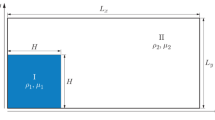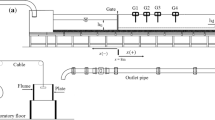Abstract
A simplified model for the prediction of the steady-state outflow through a breach in an inland dike is presented. It consists in the application of the mass and momentum conservation principles to a macroscopic control volume. A proper definition of the shape of the control volume enables to take the main characteristics of the flow into account and thus to compensate for the extreme simplification of the spatial representation of the model. At the breach, a relation derived from the shallow-water equations is used to determine the direction of the flow. Developments have been guided by numerical simulations and results have been compared to experimental data. Both the accuracy and the domain of validity of the simplified model are found satisfactory.
Similar content being viewed by others
References
Aureli F, Mignosa P (2004) Flooding scenarios due to levee breaking in the Po river. Water Manag 157: 3–12
Briechle S (2006) Die flächenhafte Ausbreitung der Flutwelle nach Versagen von Hochwasserschutzeinrichtungen an Fließgewässern (the aerial expansion of flood waves after failure of flood defence installations along rivers). Ph.D. thesis, Rheinisch-Westfälische Technische Hochschule Aachen, Aachen (in German)
Dewals B, Kantoush S, Erpicum S, Pirotton M, Schleiss A (2008) Experimental and numerical analysis of flow instabilities in rectangular shallow basins. Environ Fluid Mech 8: 31–54
Erpicum S, Dewals B, Archambeau P, Pirotton M (2010) Dam-break flow computation based on an efficient flux-vector splitting. J Comput Appl Math 234: 2143–2151
Hager W (1985) Critical flow condition in open channel hydraulics. Acta Mech 54: 157–179
Hager W (1987) Lateral outflow over side weirs. J Hydraul Eng 113: 491–504
Hager W, Volkart P (1986) Distribution channels. J Hydraul Eng 112: 935–952
Kamrath P, Disse M, Hammer M, Köngeter J (2006) Assessment of discharge through a dike breach and simulation of flood wave propagation. Nat Hazards 38: 63–78
Krishnappa G, Seetharamiah K (1963) A new method for predicting the flow in a 90° branch channel. La Houille Blanche 18: 775–778
Ramamurthy A, Tran D, Carballada L (1990) Dividing flow in open channels. J Hydraul Eng 116: 449–455
Roger S, Büsse E, Köngeter J (2006) Dike-break induced flood wave propagation. In: Gourbesville P et al (eds) 7th International conference on hydroinformatics, Nice
Roger S, Dewals B, Erpicum S, Schwanenberg D, Schüttrumpf H, Köngeter J, Pirotton M (2009) Experimental and numerical investigations of dike-break induced flows. J Hydraul Res 47: 349–359
Roger S, Dewals B, Erpicum S, Schwanenberg D, Archambeau P, Köngeter J, Pirotton M, Schüttrumpf H (2010) Hybrid modelling of dike-break induced flows. In: Dittrich A et al (eds) 5th International conference on fluvial hydraulics (riverflow), Braunschweig, pp 523–531
Vorogushyn S, Merz B, Lindenschmidt KE, Apel H (1963) A new methodology for flood hazard assessment considering dike breaches. Water Res Res. doi:10.1029/2009WR008475
Author information
Authors and Affiliations
Corresponding author
Rights and permissions
About this article
Cite this article
Stilmant, F., Pirotton, M., Archambeau, P. et al. Dike-break induced flows: a simplified model. Environ Fluid Mech 13, 89–100 (2013). https://doi.org/10.1007/s10652-012-9253-4
Received:
Accepted:
Published:
Issue Date:
DOI: https://doi.org/10.1007/s10652-012-9253-4




